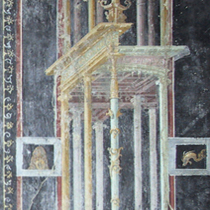 1>
1>Gods, Heroes and Ancestors (Ornate or Third Style)
To a large extent Second Style wall-painting complied with Vitruvius's belief that pictorial representation should conform to the physical laws of the known world.
“[1] (continued) ……A picture is, in fact, a representation of a thing which really exists or which can exist: for example, a man, a house, a ship, or anything else from whose definite and actual structure copies resembling it can be taken.”
Vitruvius Pollio (c.25BC), The Ten Books on Architecture (7.5.1) Morris Hicky Morgan ed. http://www.perseus.tufts.edu/cgi-bin/ptext?lookup=Vitr.+7.5.1
In contrast to Vitruvius's demand for structural realism in painting the Third or ‘Ornate’ Style as Mau named it, moved further and further away from representations of "a thing which really exists" to depictions of architectural fantasies interwoven with arabesque motifs and grotesque figures (fig.1). As the architectonic references became less real they functioned as frames for increasing amounts of figuration and narrative paintings. These mainly consisted of bucolic, sacro-idyllic and mythological landscapes inhabited by a pantheon of male and female gods accompanied by their emblemata and acolytes (fig.2). Somewhat surprisingly, this opulent rococo-like departure is usually dated to the mid-to-late Augustan period, which is normally described as a return to more stoic Roman values. This style also departed from the two previous styles by replacing faux marble representations with large monochromatic areas, normally red, black or white, and in some cases blue and even less rarely green. Slender 'stalk-like' columns and pilasters created geometric divisions in front of and between the monochromatic backgrounds, which often contained figures holding symbolic objects (fig.3). Somewhat bizarrely the irreality of these often winged figures did not provoke Vitruvius's critical eye, but the non-structural architectural references, sometimes combined with grotesque figuration, caused him to write in condemnation,
“[3] But those subjects which were copied from actual realities are scorned in these days of bad taste. We now have fresco paintings of monstrosities, rather than truthful representations of definite things. For instance, reeds are put in the place of columns, fluted appendages with curly leaves and volutes, instead of pediments, candelabra supporting representations of shrines, and on top of their pediments numerous tender stalks and volutes growing up from the roots and having human figures senselessly seated upon them; sometimes stalks having only half-length figures, some with human heads, others with the heads of animals. [4] Such things do not exist and cannot exist and never have existed. Hence, it is the new taste that has caused bad judges of poor art to prevail over true artistic excellence. For how is it possible that a reed should really support a roof, or a candelabrum a pediment with its ornaments, or that such a slender, flexible thing as a stalk should support a figure perched upon it, or that roots and stalks should produce now flowers and now half-length figures?” (fig.4.)
Vitruvius Pollio (c.25BC), The Ten Books on Architecture (7.5.3-4) Morris Hicky Morgan ed. http://www.perseus.tufts.edu/cgi-bin/ptext?lookup=Vitr.+7.5.1
1 Casa di Fabio Rufo, Pompeii
2 Villa della Farnesina, Rome – triclinium C, Museo Nazionale Romano delle Terme
3 Villa di San Marco, Stabiae
|